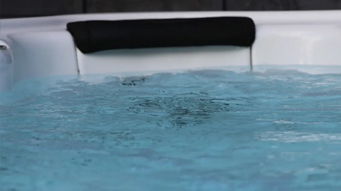How does hard water affect my hot tub and filters and how can I reduce it?
Most of us have heard the term ‘Hard water’ but what actually is it?
The definition of water hardness is ‘The amount of dissolved calcium and magnesium in the water’. This is usually formed when water percolates through natural deposits of limestone, chalk, or gypsum.
Tap water hardness differs between geographical areas throughout the country.
Our tap water usually supplied from one of two main water sources.
One source is from reservoirs that collect water from rivers and streams and natural rainwater run-off from the hills and mountains. This is usually classed as ‘soft water’.
The other is water sourced from aquafers and abstracted from ground sources. This water has usually percolated through limestone, chalk or gypsum and absorbed some of these natural minerals. This is classed as hard water.
Hard water is usually most noticeable at home by limescale in the kettle. Limescale is the result of hardwater. In the UK, water is hardest in central, eastern, and south-east England.
Now that we know what hard water is, how does this affect your hot tub?
Hard water can lead to limescale deposits forming in the hot tub, especially around the water heating elements. Calcium carbonate deposits rapidly increase at temperatures in excess of 60 centigrade, but can also form in cold water such as cold water tanks and WC cisterns.
Soft water can be the cause of water foaming and corrosion of metal parts within the hot tub system. In addition to scaling and deposits, hard water can also be the cause of cloudy water in the hot tub
How is water hardness measured?
The unit of measure is mg/l (milligrams per litre) or PPM (parts per million).
The ideal calcium (hardness) level in your hot tub is between 200-400mg/l.
The best time to check your hot tub water hardness is immediately after it has been filled whilst the water is still cold.
How do I check water hardness?
The easiest way is to use inexpensive test strips. Follow the instructions on the packaging. Dip the strip into the water and match the colour with the chart supplied, it really is that easy.
If you need to increase the water hardness, hardness increaser can be added.
Whilst it is not possible to decrease the hardness of the water already in the hot tub, it is possible to drain some of the water and replace with softened water from a domestic water softener, and thus reducing the water hardness by a certain amount. It is not generally recommended to fill a hot tub completely using a domestic water softener.
If you cannot change the water hardness, just keep on top of the pH and alkalinity levels to ensure that they are kept in balance. This should stop or reduce the likelihood of scale forming.
Loose limescale will usually be collected by the hot tub filters. If loose scale can be seen floating around then there is a fair chance that the filters will be collecting it and flow will become restricted. The filters will require changing and cleaning on a more regular basis and may require a deeper and more thorough clean to remove all the hard calcium deposits.
We recommend that you have two sets of filters to allow for thorough cleaning and drying of one set whist the other set is in the hot tub.
Quality Darlly filters are tough and robust enough to withstand repeated cleaning cycles without loosing efficiency or integrity.
Read our ‘How to clean a hot tub filter’ topic for more help about filter cleaning and the Darlly Cyclone Filter Cleaner.
If you have a suggestion for a topic that we have not yet covered, we would be more than happy to receive your suggestion. Just get in touch and we will do what we can to help.
Happy Hot Tubbing!
The Darlly Team
